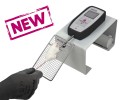Authors
Ching-Hua Lu , Axel Petzold, Bernadett Kalmar, James Dick, Andrea Malaspina, Linda Greensmith
Lab
University College London, England, United Kingdom
Journal
PLOS ONE
Abstract
Background: Amyotrophic lateral sclerosis (ALS) is an incurable neurodegenerative disorder characterised by progressive degeneration of motor neurons leading to death, typically within 3–5 years of symptom onset. The diagnosis of ALS is largely reliant on clinical assessment and electrophysiological findings. Neither specific investigative tools nor reliable biomarkers are currently available to enable an early diagnosis or monitoring of disease progression, hindering the design of treatment trials.
Methodology/Principal Findings: In this study, using the well-established SOD1 G93A mouse model of ALS and a new inhouse ELISA method, we have validated that plasma neurofilament heavy chain protein (NfH) levels correlate with both functional markers of late stage disease progression and treatment response. We detected a significant increase in plasma levels of phosphorylated NfH during disease progression in SOD1G93A mice from 105 days onwards. Moreover, increased plasma NfH levels correlated with the decline in muscle force, motor unit survival and, more significantly, with the loss of spinal motor neurons in SOD1 mice during this critical period of decline. Importantly, mice treated with the disease modifying compound arimoclomol had lower plasma NfH levels, suggesting plasma NfH levels could be validated as an outcome measure for treatment trials.
Conclusions/Significance: These results show that plasma NfH levels closely reflect later stages of disease progression andtherapeutic response
BIOSEB Instruments Used:
Grip strength test (BIO-GS3)

 Douleur - Allodynie/Hyperalgésie Thermique
Douleur - Allodynie/Hyperalgésie Thermique Douleur - Spontanée - Déficit de Posture
Douleur - Spontanée - Déficit de Posture Douleur - Allodynie/Hyperalgésie Mécanique
Douleur - Allodynie/Hyperalgésie Mécanique Apprentissage/Mémoire - Attention - Addiction
Apprentissage/Mémoire - Attention - Addiction Physiologie & Recherche Respiratoire
Physiologie & Recherche Respiratoire
 Douleur
Douleur Système Nerveux Central (SNC)
Système Nerveux Central (SNC)  Neurodégénérescence
Neurodégénérescence Système sensoriel
Système sensoriel Système moteur
Système moteur Troubles de l'humeur
Troubles de l'humeur Autres pathologies
Autres pathologies Système musculaire
Système musculaire Articulations
Articulations Métabolisme
Métabolisme Thématiques transversales
Thématiques transversales SFN2024: Venez rencontrer notre équipe sur le stand 876 à Chicago
SFN2024: Venez rencontrer notre équipe sur le stand 876 à Chicago 